In Lev Manovich’s The Language of New Media published in 2001, he analyzed the seemingly endless references to past media content, artistic styles, and forms in contemporary new media creations. He stated that “rather than assembling more media recordings of reality, culture is now busy reworking, recombining, and analyzing already accumulated media material.” In this case, can artistic creation continuously update itself? The answer is undoubtedly yes, and perhaps this approach is even more closely related to contemporary life and more effective in conveying content than mere representation.
Remix is a technique frequently used in music production, where existing tracks are edited and mixed using specific machines or computers to create new music. Therefore, in a remixed song, one can hear familiar melodies in different forms and combinations. The exhibition borrows the concept of remixing to understand how artists sample their daily lives and create sensory experiences that extend from but differ from their initial memories and general perceptions.
The exhibition features six groups of artists, presenting a total of ten works, including video installations, kinetic installations, and spatial installations. On the performance side, four groups of artists offer immersive audio-visual live performances. I elaborate on the remix strategies of these works through three subtopics: direction, scale, and boundaries, which can serve as a reference for entering the works. Of course, you are also free to explore according to your own preferences.
列夫.曼諾維奇(Lev Manovich)在 2001 年出版的《新媒體的語言》(The Language of New Media)中,曾分析當時新媒體創作的似乎不斷地引用過去的媒介內容、藝術風格與形式,相較於「更多對於現實的記錄,如今的文化忙於再製、再造與分析已經累積起來的媒介素材。」在這樣的狀況下,藝術創作有可能不斷自我更新嗎?答案必然是肯定的,甚至相較於再現,這也許是更貼近當代生活,且更能有效傳遞內容的路徑。
重混(Remix)是音樂創作上經常使用的手法,通常使用特定機器或電腦將已有的樂曲剪輯、混合,藉此產生出新的音樂。因此在一首重混的歌曲中,可以聽到某些熟悉的旋律,以不同的姿態與組合發生。展覽借用重混的概念,理解藝術家們如何取樣他們的日常,創作出延續但異於他們最初記憶與一般認知的感官經驗。
在展覽部分呈現六組藝術家/團隊、共十件作品,含括錄像裝置、動力裝置、空間裝置等形式;演出方面則由四組藝術家,帶來沈浸式的聲音視覺(audio-visual)現場表演。我藉方向、尺度與邊界三個子題闡釋這些作品的重混手法,不妨作為進入作品的路徑參考,當然你也可以完全依照自己的喜好遊走。




Reorientation…
In Remigrate, we follow Hu Ching-Chuan as she returns to Hua Xin Street, the Myanmar Street, in Zhonghe, where she grew up. Ching-Chuan uses 3D scanning to recreate the streetscape in the digital world, and transforms her embodied memories of walking through the model with camera movements. The space presented in the film is not composed of real geographic coordinates but is a discontinuous landscape that intertwines her personal memories and family history. It also reflects her new understanding of nostalgia in the digital age. People’s resistance, fear, and eventual acceptance of new technology——this process of change, like migration, seems to constantly lead us to construct new lifestyles.
Also exploring the sense of direction in their work are Su Tsan-Yuan’s two video installations Planet and Single-Storey Building. In Planet, the central projection light source continuously rotates. As the light source turns to different liquid crystal screens, we can see the images on them. The artist has created a model of his living space that may face urban renewal and further produced a 3D animation. By deconstructing and modifying the liquid crystal screens, Tsan-Yuan attempts to re-examine the relationship between home and self from an anatomical perspective, just as the relationship between the light source and the images in the installation shows a state of intersubjectivity.
In contrast to Planet, which presents horizontal light changes, Single-Storey Building deconstructs the domestic space from a vertical direction while continuing to explore the relationship between home and space. The original vertical floor layout of the row house is disassembled and placed in a flat four-channel video. Looking up at this box installation made of screens and mirrors, viewers will discover an infinitely extending space within, yet unrecognizable in terms of floor features. Just as old houses are rebuilt into elevator apartments, the perception of living spaces is standardized, leaving the only difference between living on a lower and a higher floor to be the elevator buttons.
重新定位中…
在《回流》中,我們跟著胡鈞荃回到他童年生長的中和「緬甸街」華新街。鈞荃運用 3D 掃描的方式,將街景在數位世界中重新拼貼,並以在模型中的運鏡轉化行走的身體記憶。片中呈現的並非由真實地理坐標組成的空間,而是雜揉著其個人記憶與家族歷史的不連續地景,以及成長於數位時代對於鄉愁的新解——人們面對新技術時的拒斥、恐懼到接受,這種「變遷」似乎讓我們不斷重複構築新的生活型態。
同樣在作品中調度方向感的還有蘇粲淵的兩件影像裝置《行星印象》與《單層透天》。《行星印象》的結構正中間的投射光源不斷自轉,當光源轉向不同方位的液晶屏幕時,我們就能看到上面的圖像——藝術家將其可能面臨都市更新的住家空間建成模型,並進一步製成 3D 動畫。透過拆解、改造液晶螢幕這種影像機器,粲淵試圖用一種解剖的視角,重新思考家與自身,正如裝置中光源與影像相互依存、互為主體的關係。
對比《行星印象》以水平的光線變化呈現,《單層透天》則是從垂直方向著手解構家屋空間,但仍延續對於家與空間的思考。原本透天厝垂直的樓層設置被拆解並置在扁平的四頻道的影像中,觀眾仰頭觀看這個由螢幕與鏡面組成的方盒裝置,便會發現這個盒中藏有一個無限延伸但卻無從辨識樓層特色的空間。正如從老屋都更改建成電梯公寓,將人對於居住空間的感知規格化,於是住在低樓層與高樓層的差異,只剩下電梯按鈕。



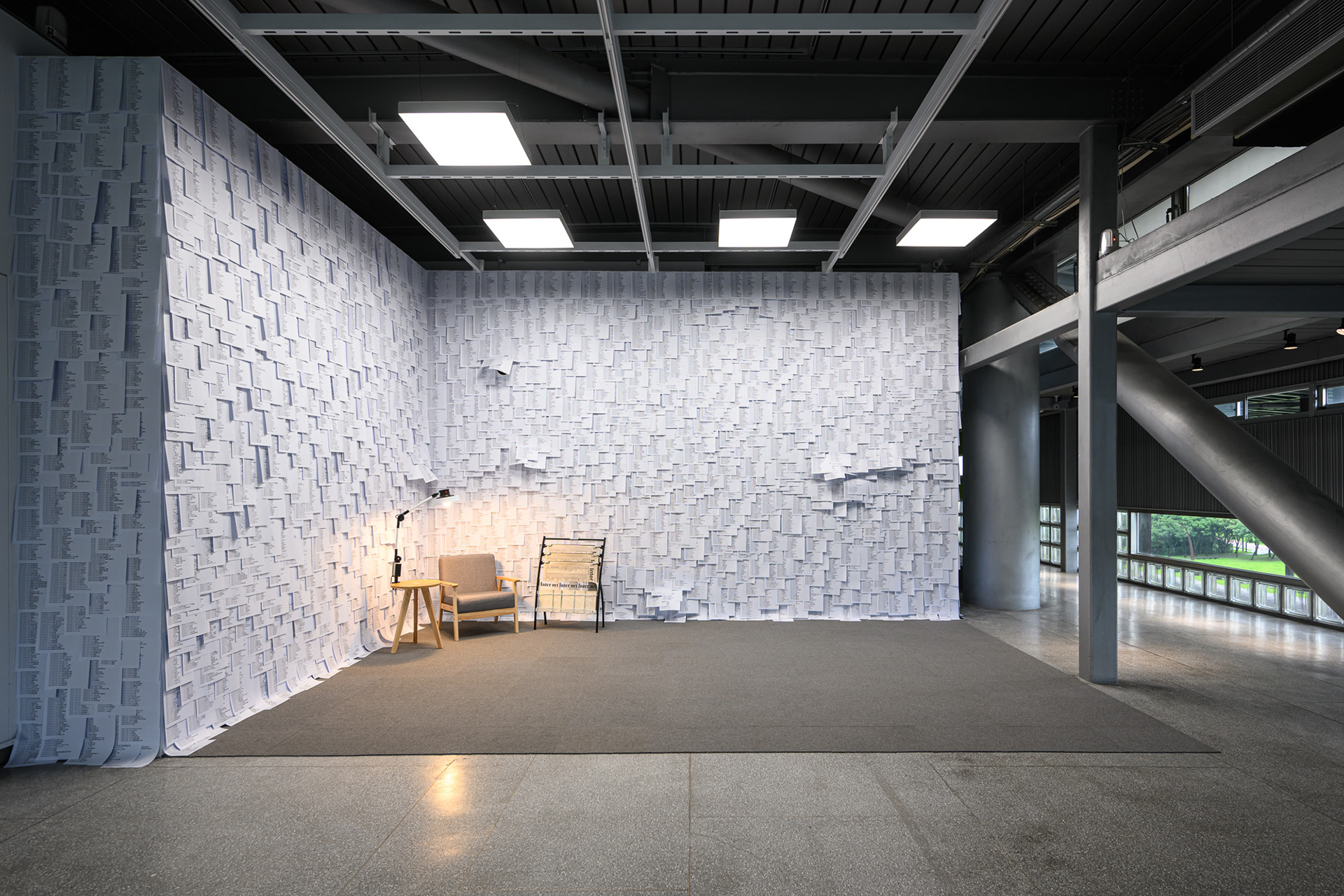
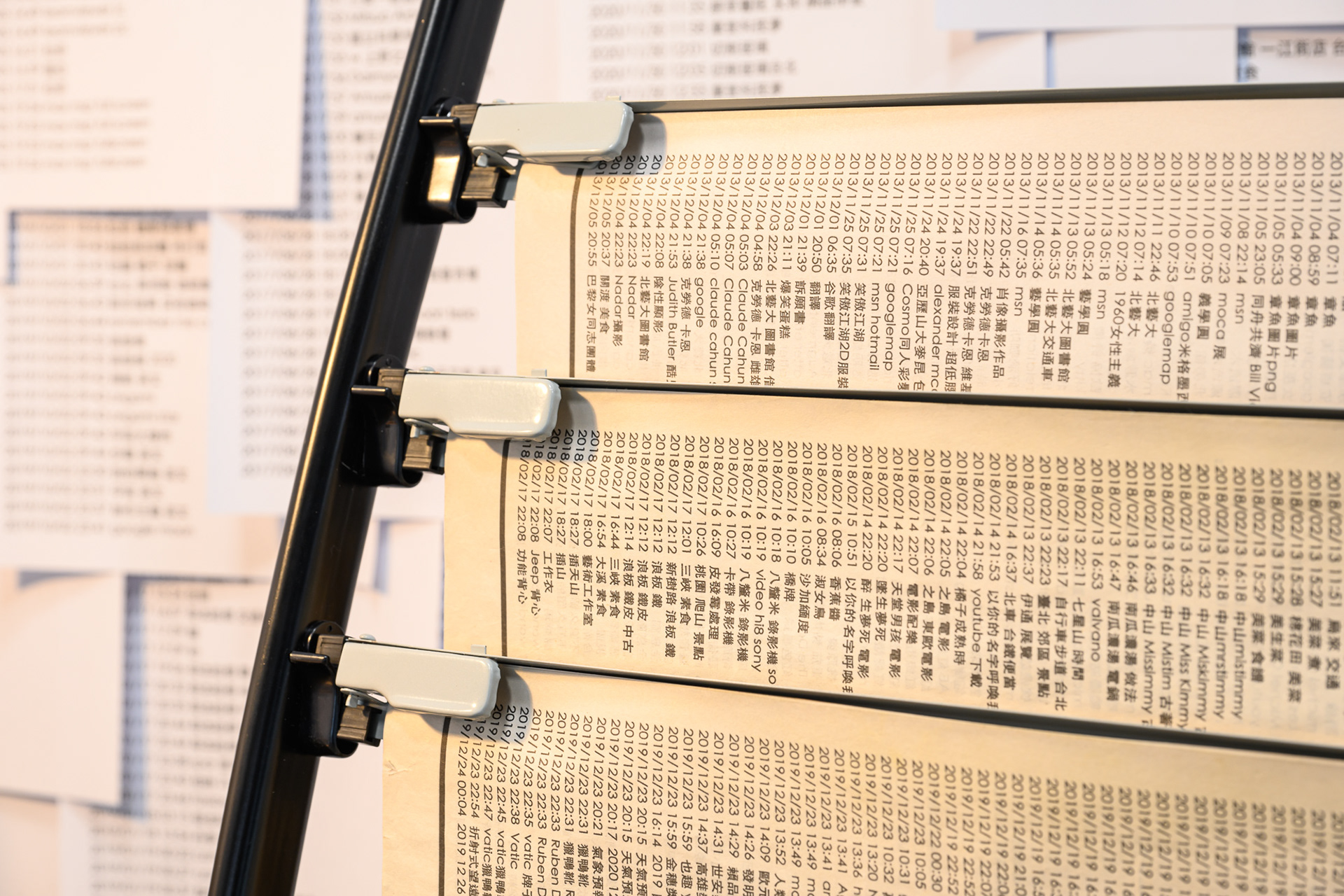
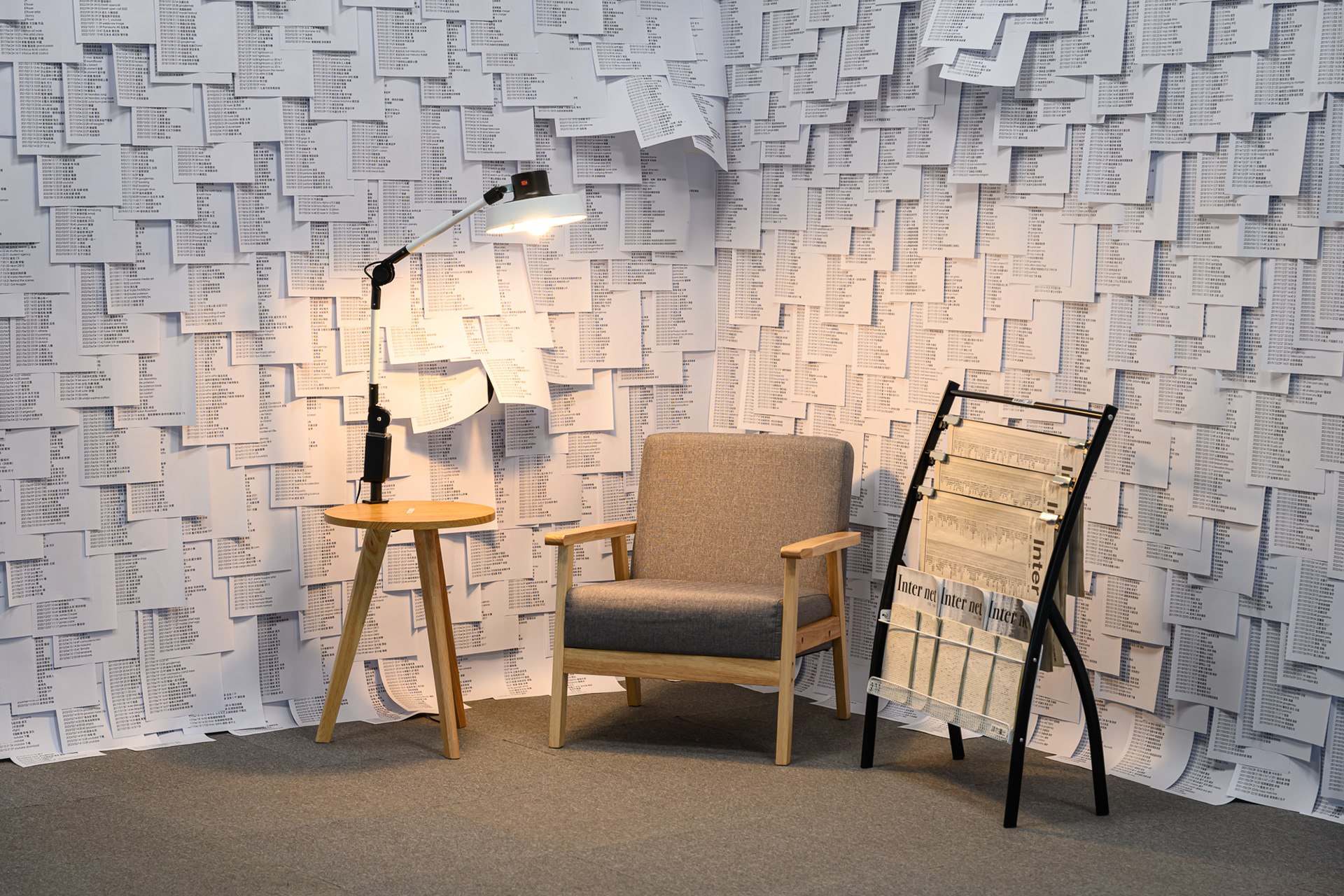
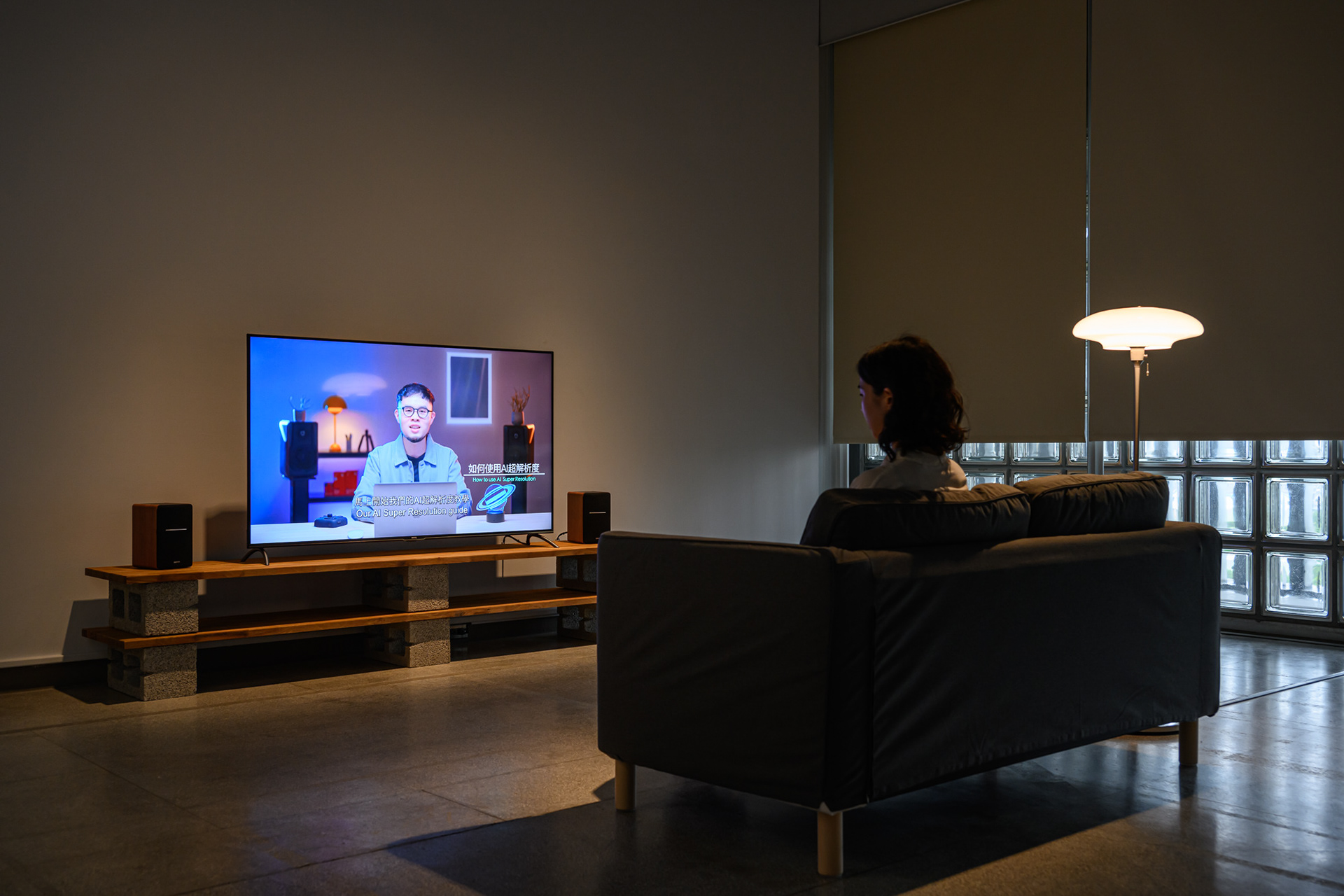

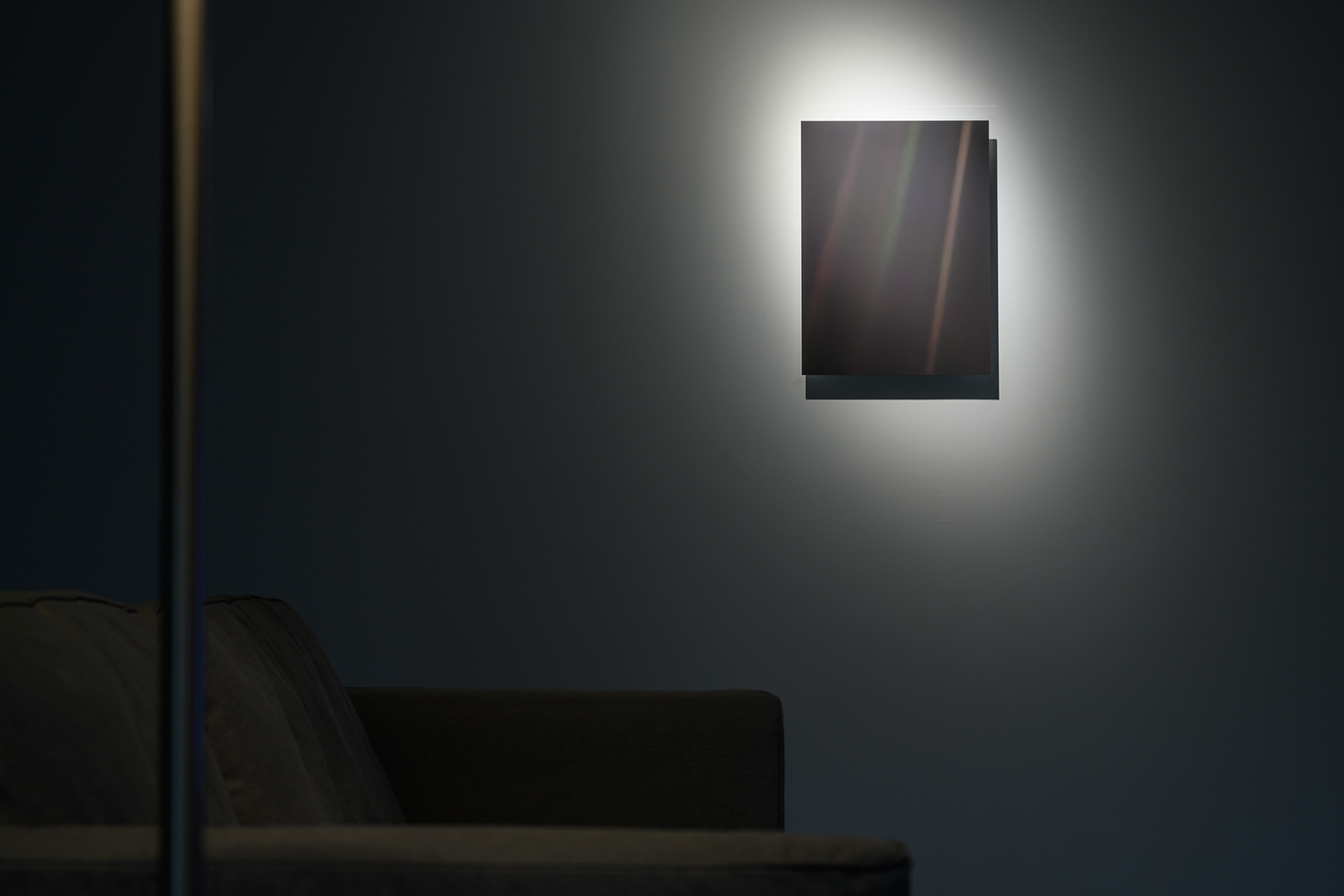
Alien Scales of Things
When familiar objects appear at unfamiliar scales, they always subvert our understanding. Hsieh Yu-Cheng’s Star Cluster: Port produced on-site for this exhibition, continues his exploration of luminescent materials since 2016, constantly creating images through a method of “bypassing machines”——without any image signals input or output through machines, yet strongly evoking the presence of image machines. The artist strings together plastic fragments painted with RGB colors into bead curtains, cutting across the exhibition space, as if a huge LED screen looms before us. In front of this glowing screen that displays no specific content, people seem tiny and insignificant, and pushing aside the bead curtains seems to allow passage to the other side of the screen. White Null in the same room can be seen as an intertext of Star Cluster: Port. The video shows a close-up of water droplets sliding across the screen, magnifying the numerous RGB pixels that compose the LED screen, allowing us to glimpse the underlying structure of image generation.
Inter net II by Simple noodle art (Chen Zi-Yin X Chuang Gotop) presents a situation in which people cannot grasp the amount of data they create. It is almost impossible to imagine a life without the internet, or even to have never experienced such a time; “Ask Google for everything” has become a contemporary belief. The artist accidentally discovered that Google had retained her more than 70,000 search records over the past decade. She printed out all of these records to display, revealing private yet extremely objective and detailed search records like a diary, laid bare in front of the audience. Every curious, troubled, worried, or malicious search accumulates into a personal-centered data collection. Inter net II transforms this everyday experience through a concrete installation: Google remembers what you have forgotten.
Chen Zi-Yin’s How To Improve Photo Quality by AI | Noise Reduction, Super-resolution Tutorial orchestrates another understanding of scale, from the vastness of space to a single pixel in a photo. The work mimics a common YouTube tutorial, using the 1990 photograph “Pale Blue Dot”, taken by the space probe Voyager 1, as a demonstration of AI noise reduction and super-resolution image editing. “Consider again at that dot,” accompanied by the moving voiceover of astronomer Carl Sagan, we will witness AI image editing software efficiently transform the small dot in the “Pale Blue Dot”——the Earth captured from 6.4 billion kilometers away——into a smooth, high-resolution photo. It is as if, in the world of AI, the planet on which humans dwell has never existed.
陌生的尺度
當熟悉的事物以陌生的尺度出現,總是顛覆我們的理解。謝佑承為本次展覽現地製作的《星叢:埠口》,延續了他自 2016 年以來對於螢光材料的探索,不斷地透過「繞過機器」的方式製造影像——沒有任何影像訊號透過機器輸入或輸出,卻讓人強烈感受到影像機器的在場。藝術家將塗上 RGB 三色的塑膠碎片串成珠簾,切過展場空間,像是一道巨大的 LED 螢幕橫亙在我們面前。在這片發著光但卻不顯示任何明確內容的螢幕之前,人顯得渺小,撥開珠簾彷彿可以穿越到螢幕的另一面。同一展間中的《白露》可視為《星叢:埠口》的互文。錄像中播放實拍水珠滑過螢幕的畫面,水珠將組成 LED 螢幕的無數 RGB 像素放大,我們得以一窺影像生成的底層結構。
陽春麵研究舍(陳姿尹 X 莊向峰)的《inter net II》則呈現出人們無法掌握自身製造出的資料量的處境。我們幾乎無法想像一個沒有網路的生活,甚至從未經歷過那樣子時代,「萬事問 Google」已經是一種當代信仰。藝術家在無意間發現 Google 保留了他 10 多年來、 7 萬多筆搜尋紀錄,並將這些紀錄全數印出展示,把如日記般私密的卻又極度客觀詳實的搜尋紀錄,毫無保留地攤開在觀眾面前。每一次好奇、苦惱、擔心或不懷好意的搜索,都累積成以個人為中心的資料集合,《inter net II》透過具象化的裝置轉化這種日常經驗:你忘記的,Google 都記得。
陳姿尹《如何使用 AI 提升照片品質 | Noise Reduction、Super Resolution教學》調度了另一種對於尺度的理解,從浩瀚無垠的太空談到照片上的一格像素。作品擬彷 Youtube 上常見的教學影片,使用 1990 年由太空探測器「航海家 1 號」拍下的照片《暗淡藍點》作為 AI 降躁與超解析度的修圖示範。「讓我們再看一眼這個小圓點。」伴隨著天文學家卡爾・薩根(Carl Sagan)動人的口白,我們將目睹 AI 修圖軟體將《暗淡藍點》中拍到的小圓點——從 64 億公里外拍攝到的地球,乾淨俐落地修成平滑的高解析度照片,彷彿在 AI 的世界中,人類所居住的這個星球從未存在過。

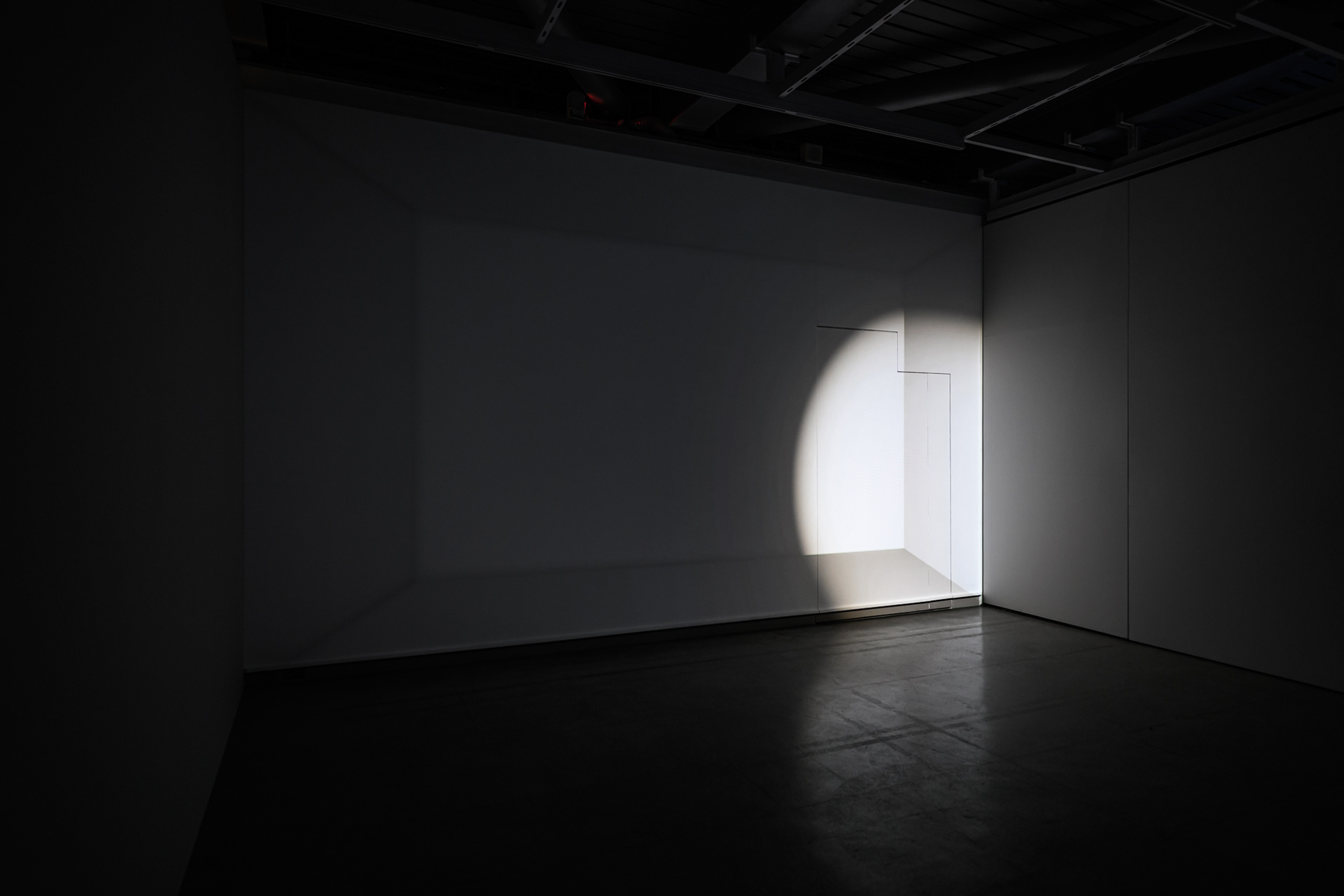
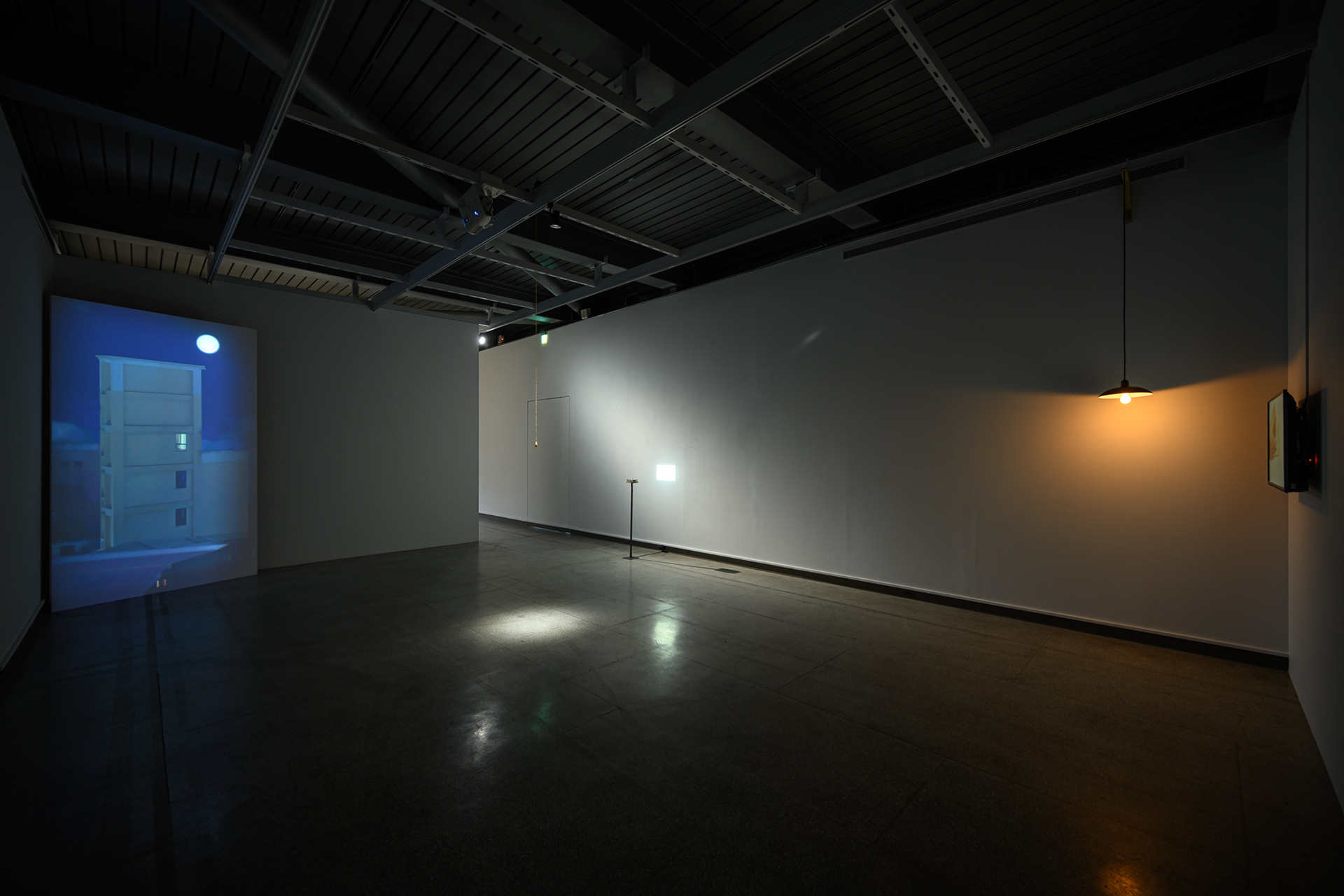
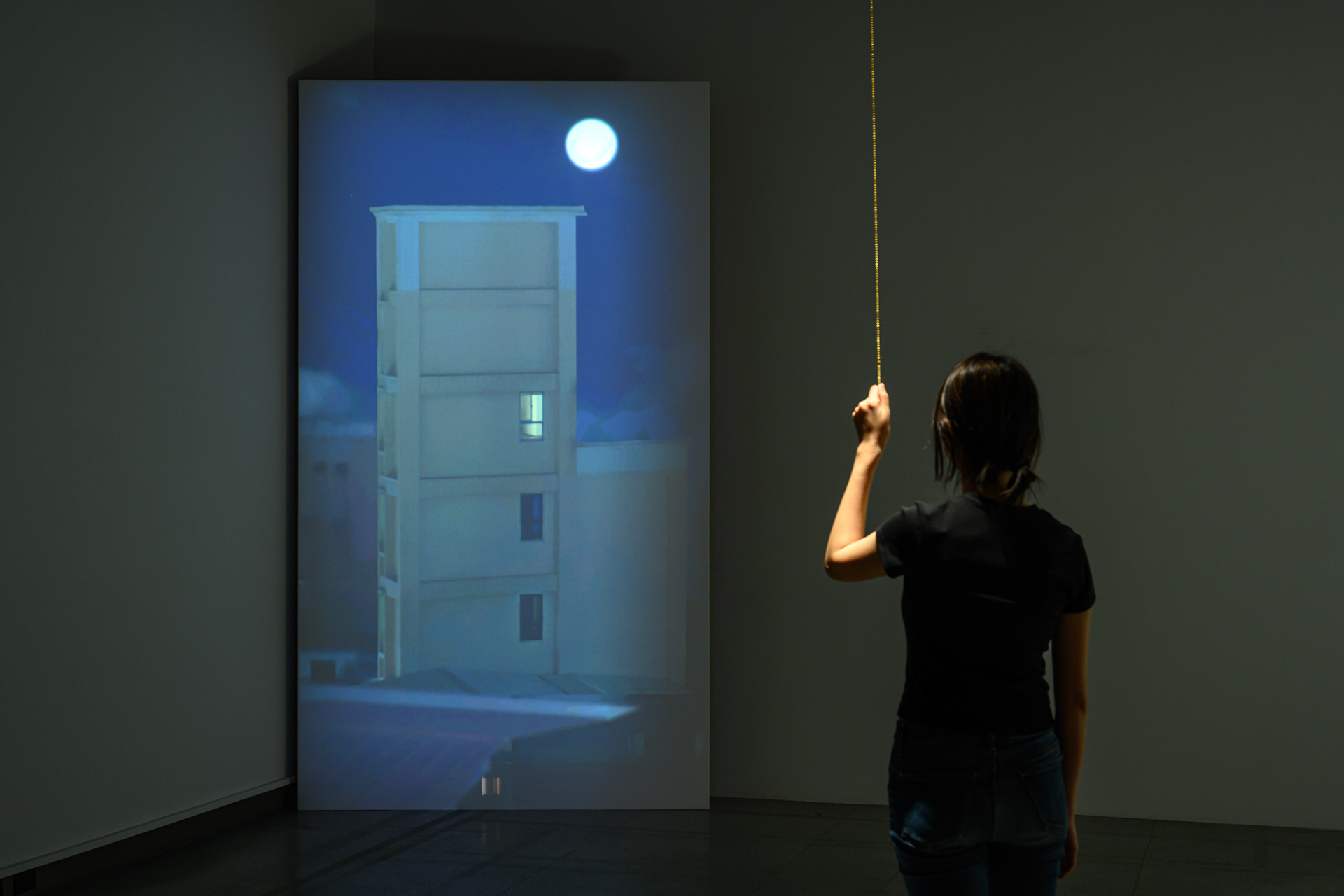


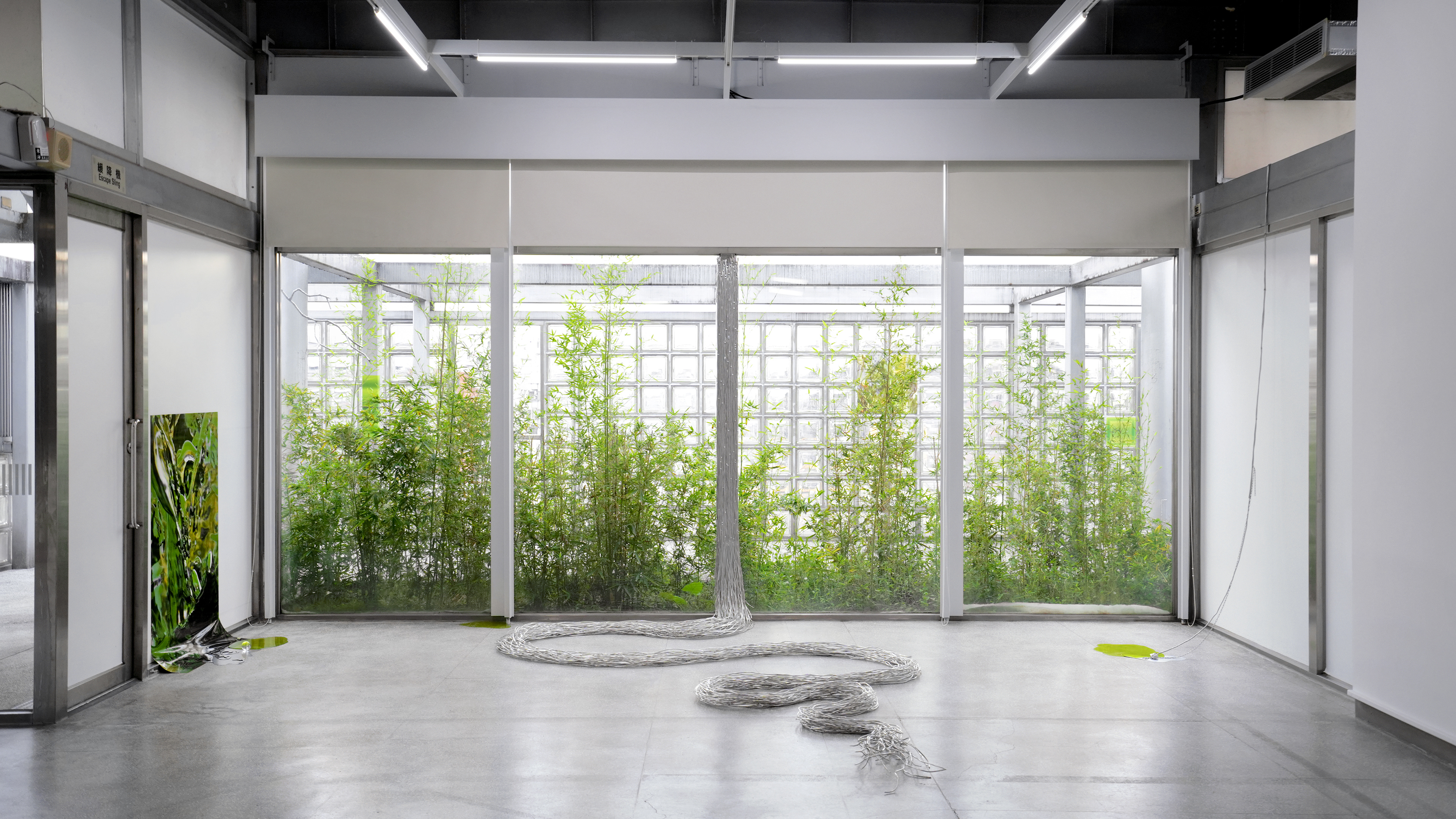
Blurring the Boundaries
Boundaries are crucial to our understanding of the relationships between ourselves and others. Lin Che-Yu’s The Daily Moments and The Fourth Wall create a familiar yet unfamiliar daily landscape with a light touch. The Daily Moments connects the virtual switches and lights in the projected image through programming. When the lights in the image are turned off or adjusted for brightness, the brightness of the image changes accordingly; conversely, when the audience pulls one of the on-site switches, the lights in the image also toggle. It seems as if the here and now is connected to an unknown or even completely fictional world in such a subtle way.
The Fourth Wall creates a seemingly existent but actually non-existent wall in the exhibition space, “attempting to extend the image from reality.” In theater and film theory, the “fourth wall” refers to the one-way invisible wall near the audience seats on a proscenium stage or screen. Actors seem unable to see the audience, while the audience witnesses the drama from an omniscient perspective. In Che-Yu’s work, this “fourth wall” appears in a different way, probing the boundaries between reality and fiction.
Finally, Hu Ching-Chuan’s installation Awakening is situated in front of a large glass panel at the end of the well-lit exhibition space. The artist uses program-controlled artificial branches to tap on the window, creating a sudden disturbance in the quiet exhibition space with a deft touch. This prompts people to start observing their surroundings and searching for the origin of the disturbance, an experience that could be understood as serendipity. Going back to the question at the beginning of the article, can the continuous referencing, reproducing, reconstructing, and analyzing creative methods constantly bring forth new ideas? Perhaps we can further ask if we are aware of serendipity in our daily lives and explore along those lines.
Physicist Carlo Rovelli proposes a counterintuitive yet poetic idea in his book The Order of Time: to see the world as a network of events rather than a composition of physical matter. By viewing things through a longer lens of time, we can understand that certain things that seem unchanging only temporarily exist in seemingly unchanged forms, and the world may be closer to a combination of perceptual events.
The artworks are extracted from their original creative context and combined in the exhibition to meet the audience as an event. We can also understand the exhibition as a remix. In the arrangement of the exhibition space, we have designed a sequence for reading these works. However, their relationships are not fixed, and each visit to the exhibition can be a new reading. Which corner of the exhibition makes you feel particularly connected? Which work seems especially distant to you? Or even on an unknown day after leaving the gallery, you may find a moment in your daily life that overlaps with today’s memories.
Sensation remix, wildly welcomed.
擾動邊界
邊界是我們認知自我與他者/他物關係的關鍵,林哲宇的《日常時光》與《第四面牆》以輕巧的姿態,創造出一種熟悉卻又陌生的日常景觀。《日常時光》透過程式設計,連動投影畫面中的虛擬開關與燈光,當影像中的燈被關閉或者調整亮度,影像的亮度也會跟著改變;或者反過來,當觀眾拉動其中一組的現場開關,畫面中的燈也會隨之開關。彷彿我們所處的此時此刻與某個未知時空甚至完全虛構的世界,以這樣幽微的方式相連。
《第四面牆》則在既有的展場裡,創造一道看來起存在,但實際上並不存在的牆,「試圖讓影像從現實中延展開來。」在戲劇與電影理論中的「第四面牆」,指涉的是存在於鏡框式舞台或銀幕上靠近觀眾席的這一道單向隱形牆面,演員彷彿看不見觀眾,而觀眾像是全知者般以旁觀視角見證戲劇發生。在哲宇的作品中,這道「第四面牆」以不同的方式現身,探觸現實與虛構的邊界。
最後是胡鈞荃的裝置《喚》,座落在亮間展場的底端的大片玻璃前。藝術家利用程式控制讓一根人造樹枝敲擊窗戶,舉重若輕地,在寧靜的展場空間中創造出突然的擾動,讓人開始觀察自己所處的周遭環境,尋找這個擾動的起始點,這樣的經驗或許可以理解成某種不經意的奇緣(serendipity)。回到文章開頭的提問,不斷地引用、再製、再造與分析的創作方式有可能不斷推陳出新?或許也能進一步問,我們是否覺察在日常生活中的奇緣,並循線探索。
物理學家卡羅.羅維理(Carlo Rovelli)在《時間的秩序》一書中,曾提出一個有點違反直覺但卻無比詩意的想像:請將世界看成事件的網絡,而非實體物質的組成。只要拉長時間來看,便能理解某些看似不變的事物,僅是暫時以看起來不變的型態存在,世界或許更些近一連串感知事件的組合。
這些作品從它們原先各自的創作脈絡中被抽取出來,安放在這個展覽中,重新以展覽這個事件的面貌與觀眾相遇。我們不妨將展覽本身理解成一首重混。在展場空間的安排上,設計了一套閱讀這些作品的順序,然而它們彼此間的關係並非固定的,每一次進到展場中,都可以是一次新的閱讀。展覽的哪個角落讓你特別有感覺?哪一件作品對你來說格外疏遠?又甚至在離開美術館後的未知的一天,你會發現日常生活的某個瞬間與重疊今天的記憶重疊。
歡迎加入感覺重混的行列。
Supervisor: Yilian County Government
Organizer: Cultural Affairs Bureau, Yilian County Government
Executive Organizer: ZIMU CULTURE CO., LTD
Organizer: Cultural Affairs Bureau, Yilian County Government
Executive Organizer: ZIMU CULTURE CO., LTD
𝗘𝗫𝗛𝗜𝗕𝗜𝗧𝗜𝗢𝗡.𝗔𝗥𝗧𝗜𝗦𝗧𝗦
Hsieh Yu-Cheng Hu, Ching-Chuan, Lin Che-Yu, Chen Zi-Yin, Simple noodle art (Chen Zi-Yin X Chuang Gotop), Su Tsan-Yuan
Hsieh Yu-Cheng Hu, Ching-Chuan, Lin Che-Yu, Chen Zi-Yin, Simple noodle art (Chen Zi-Yin X Chuang Gotop), Su Tsan-Yuan
Space Design and Technical Coordinator: Ko Ta-Sheng
On-site Production and Installation: UN ART (Chiang Tso-Yu, Lin Zhe-Zhi, Lin Yu-Liang, Chen Zi-Yin, Ko Ta-Sheng)
Visual Design: Onejin Lai
Interactive Media Programming: Chuang Gotop
Kinetic Installation Design: Wang Liang, Jeff Lai
“Translator”: ChatGPT Mar 23 Version (GPT-4)
Photography (Installation view): Anpis Wang
Videography (Installation view): Ko Ta-Sheng, Lin Che-Yu
Photography (Behind the scenes, opening ceremony): Lo Siang-Ting
On-site Production and Installation: UN ART (Chiang Tso-Yu, Lin Zhe-Zhi, Lin Yu-Liang, Chen Zi-Yin, Ko Ta-Sheng)
Visual Design: Onejin Lai
Interactive Media Programming: Chuang Gotop
Kinetic Installation Design: Wang Liang, Jeff Lai
“Translator”: ChatGPT Mar 23 Version (GPT-4)
Photography (Installation view): Anpis Wang
Videography (Installation view): Ko Ta-Sheng, Lin Che-Yu
Photography (Behind the scenes, opening ceremony): Lo Siang-Ting
Curator: Lee Chia-Lin
Administrative Assistant: Hong Bao-Yi, Lin Wen-Ling
Administrative Assistant: Hong Bao-Yi, Lin Wen-Ling
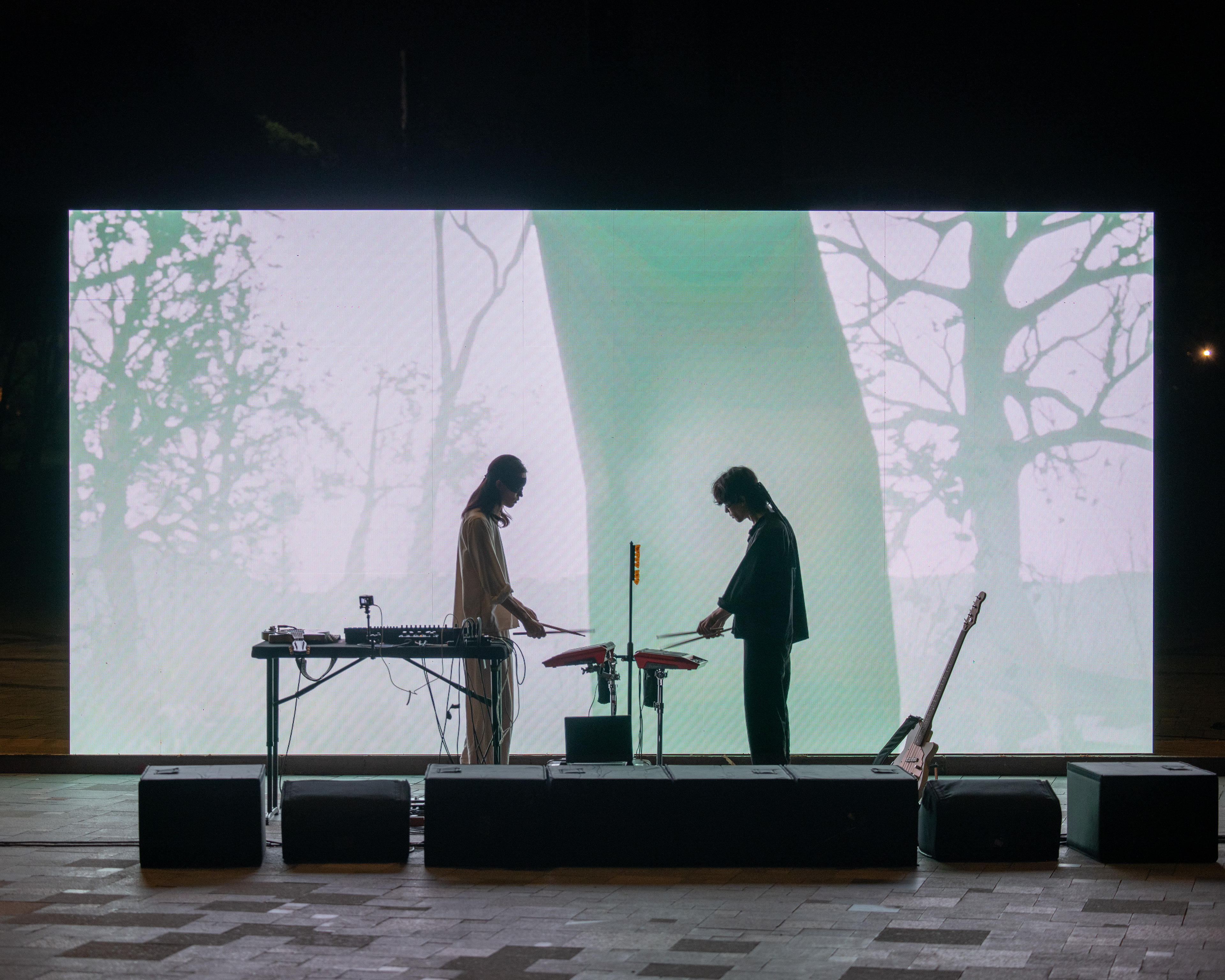
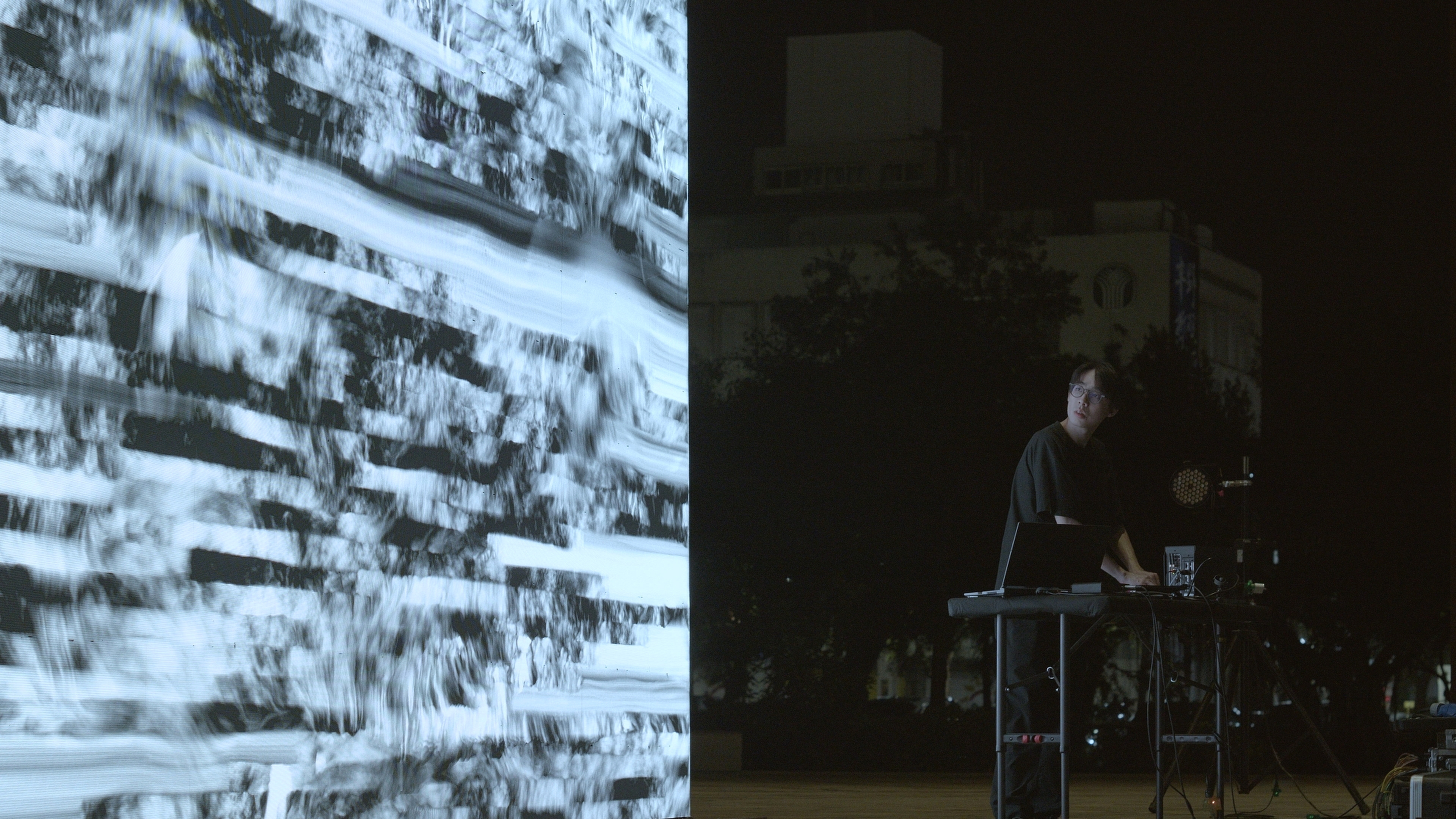
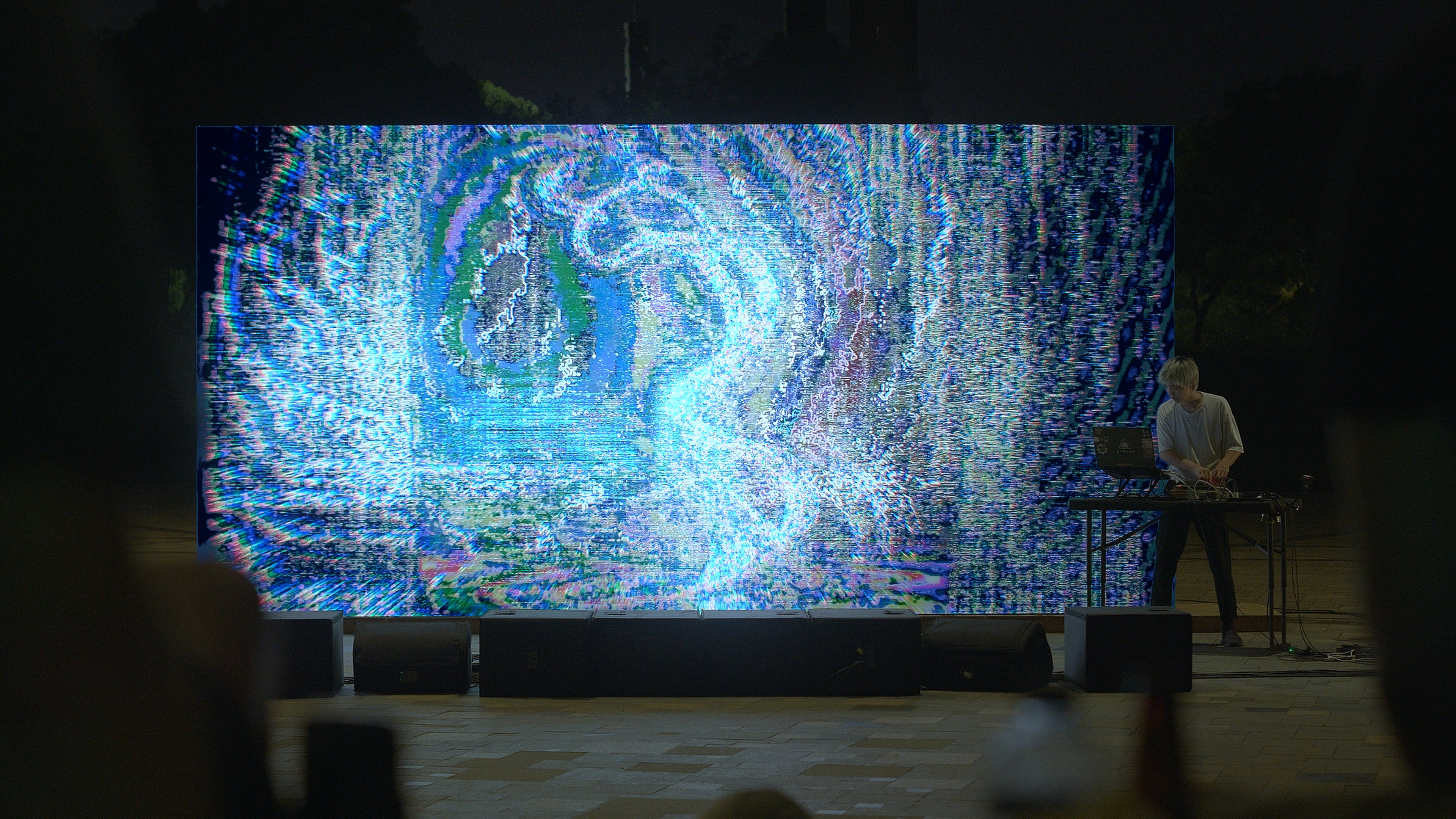


𝗔𝗨𝗗𝗜𝗢-𝗩𝗜𝗦𝗨𝗔𝗟 𝗣𝗘𝗥𝗙𝗢𝗥𝗠𝗔𝗡𝗖𝗘.𝗔𝗥𝗧𝗜𝗦𝗧𝗦
Huang Wei, Chang Hsin-Yu, Wu Cheng-Lu, Luca Bonaccorsi, Mong Tong x XTRUX
Huang Wei, Chang Hsin-Yu, Wu Cheng-Lu, Luca Bonaccorsi, Mong Tong x XTRUX
Audio-visual Performance Organizer: Huang Wei
Audio-visual Performance Sponsor: Agrioz, Jim & Dad's Brewing Company
AV Rental and Engineering (Opening ceremony): Ramp Music Studio
AV Rental and Engineering (Audio-visual Performance): 玩樂生活有限公司
Videography (Audio-visual performance): Bokeh STUDIO
Photographic Record (Audio-visual performance): Wang Cheng-Sean
Management Company of Mong Tong: In Utero Ltd.
Audio-visual Performance Sponsor: Agrioz, Jim & Dad's Brewing Company
AV Rental and Engineering (Opening ceremony): Ramp Music Studio
AV Rental and Engineering (Audio-visual Performance): 玩樂生活有限公司
Videography (Audio-visual performance): Bokeh STUDIO
Photographic Record (Audio-visual performance): Wang Cheng-Sean
Management Company of Mong Tong: In Utero Ltd.
Audio-visual Performance Trailer Visual Design (Documentary opening): Huang Wei
Audio-visual Performance Trailer Audio Design (Documentary opening): Luca Bonaccorsi
Documentary Editor: Ko Ta-Sheng, Chen Yen-Cheng
Documentary Audio Design: Wu Cheng-Lu
Audio-visual Performance Trailer Audio Design (Documentary opening): Luca Bonaccorsi
Documentary Editor: Ko Ta-Sheng, Chen Yen-Cheng
Documentary Audio Design: Wu Cheng-Lu
Special Thanks to Yang Chen-Hao, Chuang John, artgong, Sandwishes Studio, Initial Complex, Da Yuan Fruit.